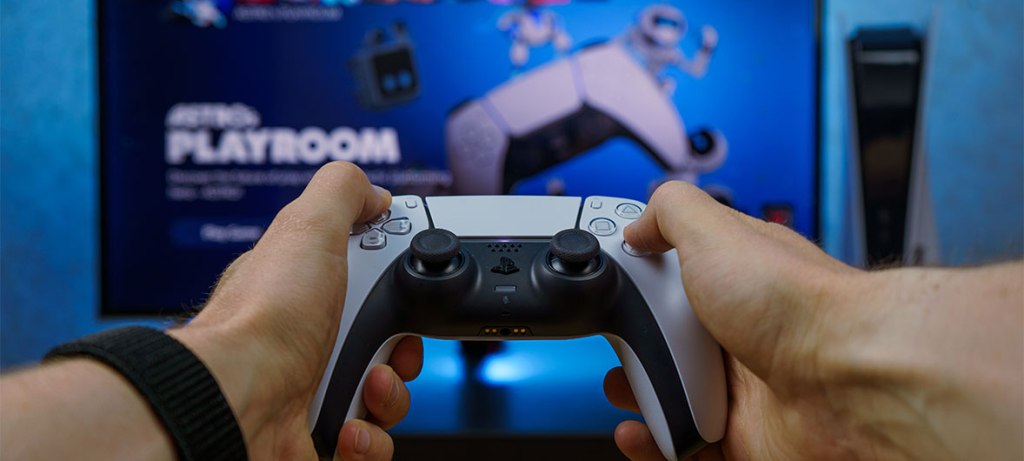
Think about the following questions.
1. Do you play computer, console, or mobile games? Which types of games do you play?
2. What are the most popular games at the moment? Do you play them?
3. Do you know anyone who is addicted to games? If so, why do you think that person became addicted?
VOCABULARY PREVIEW
Match each New Academic Word List(NAWL) word with the correct definition.
- stereotype
- productive _____
- portray _____
- niche _____
- incidence _____
- statistic _____
- a. to show or describe someone or something
- b. how often something happens, especially something bad
- c. a number that represents a piece of information
- d. an often unfair and untrue belief that many people have about all people or things with a particular characteristic
- e. working hard and getting good results
- f. interesting to, aimed at, or affecting only a small number of people
GAMERS: IMAGE AND REALITY

Video games have come a long way since they first emerged1 as a niche pastime in the 1970s. In 2020, the global video-game market was worth approximately2 $150 to $160 billion, and it is predicted to continue growing at a rapid pace. Much of this growth is credited to new software and the increasing affordability of mobile devices. According to the Entertainment Software Association (ESA), three out of every four US households include someone who plays video games. Yet, despite the popularity of gaming, there are many negative stereotypes attached to being a gamer. This raises the question: how do the stereotypes compare to reality?
Gamers are often portrayed negatively in the media. This can be seen in shows such as The Big Bang Theory, where the game-obsessed lead characters are noticeably lacking3 in social skills. A common stereotype is that gaming is an activity for boys and young men who lack the energy and motivation to do anything constructive4. This leads many people to believe that gamers are unhealthy and unlikely to be productive because they devote little time to exercise, creative hobbies, and schoolwork. It also leads to fears that young gamers won't be able to hold jobs when they leave school.
As with any group, there are people who fit the stereotypes. However, studies have found that video-game players are far more diverse than we are led to believe. The ESA found in 2018 that gamers primarily consisted of adults, not children. They also found that forty-six percent of gamers were women. Gamers were also not as lazy as some assumed. US unemployment, particularly among young adults in their twenties, steadily declined between 2010 and 2020. Additionally, fifty-six percent of gamers reported that they regularly participated in creative activities, such as drawing, singing, and writing. Lastly, regarding health, a study at the University of Wurzburg found that only one percent of adult gamers' health problems could be directly linked to gaming and that no significant5 link between games and poor health among children and teenagers existed.
The most serious charge against gamers, however, comes from the belief that games contribute6 to violence7. High-profile crimes, such as the Sandy Hook shootings8 in the US, have been linked to violent games. Yet, there is no solid evidence connecting video-game violence with real-world violence. In 2020, the American Psychological Association found that violent video games did increase "aggression9." However, the study pointed out that aggression is not the same as violence. Looking at US crime statistics, researchers also found that violent crime, particularly among the young, has decreased since the early 1990s. Additionally, the incidence of violent crime in other countries where violent video games are popular is lower than in the US.
If we look past the stereotypes, we can find that gaming has some positive effects. In 2020, the COVID-19 pandemic led to mass quarantines. People turned to games and social media to relieve their boredom. Games such as Animal Crossing: New Horizons became popular topics of social discussion. Rishi Chadha, global head of gaming partnerships at Twitter, noticed the game's impact by tracking conversation volume on Twitter. He found that conversation about the game had grown by over 1,000 percent since its launch, and the number of people tweeting about the game had increased by over 400 percent. That's more than thirty-eight million tweets!
It's easy to find examples that support negative stereotypes about gamers. But contemporary10 research shows gamers are far more complex and diverse than the stereotypes would suggest. Perhaps it's time to reevaluate our image of gamers to better match reality.
New Academic Word List
- emerge 1 : v. to become known or apparent
- approximately 2 : adv. almost correct or exact
- lacking 3 : adj. not having any or enough of something that is needed or wanted
- constructive 4 : adj. helping to develop or improve something
- significant 5 : adj. large enough to be noticed or have an effect
- contribute 6 : v. to help to cause something to happen
- violence 7 : n. the use of physical force to harm someone, to damage property, etc.
- shooting 8 : n. an occurrence in which a person is shot with a gun
- aggression 9 : n. angry or threatening behavior
- contemporary 10 : adj. happening or beginning now or in recent times
READING COMPREHENSION
A ‣ Mark each statement as true (T) or false (F) according to the reading.
- A majority of American households include at least one gamer.
- True
- False
- The media often portrays gamers as socially confident.
- True
- False
- More teenage boys play video games than any other group.
- True
- False
- Experts have found that violent games encourage aggressive behavior.
- True
- False
- Many people played games on social media during quarantine.
- True
- False
B ‣ Choose the best answer according to the reading.
- What is the main purpose of the reading?
- a. To show how the gaming industry has increased in value
- b. To compare the stereotypes and realities of gaming
- c. To describe the growing popularity of mobile gaming
- d. To explain the development of games since the 1970s
- Which is NOT a stereotype about gamers?
- a. Gamers are highly motivated.
- b. The majority of gamers are male.
- c. Gamers tend not to be athletic.
- d. Socializing is difficult for gamers.
- What can be inferred from paragraph 4?
- a. Violent games are more popular in the US than elsewhere.
- b. Many people believe games are a major cause of violent crime.
- c. The US experiences more crime than other countries.
- d. Violent crime is likely caused by factors other than violent games.
- The word its in paragraph 5 refers to _____.
- a. Twitter
- b. social media
- c. Animal Crossing: New Horizons
- d. COVID-19
C ‣ Find the correct numbers in the reading and write them on the lines.
- _____: the approximate value of the video-game market
- _____: the percentage of gamers that reported participating in creative activities
- _____: the number of tweets that talked about Animal Crossing: New Horizons
SUMMARY
Fill in the blanks with the phrases in the box.
- range of hobbies
- commit violent acts
- social skills
- large minority
- a negative impact
- have the energy
|
Gamers |
|
|
Image
|
Reality
|
VOCABULARY PRACTICE
Fill in the blanks with the words in the box. Change the form if necessary.
- niche
- statistic
- incidence
- portray
- stereotype
- productive
- Have you seen the latest employment _____ for young adults?
- I wasn't very _____ this weekend. I just stayed at home and played games.
- The newspapers have _____ her as a real hero.
- The _____ of cheating in final exams was extremely high.
- Train watching is a really _____ hobby.
- I think you should get to know people rather than relying on _____.
SUPPLEMENTAL READING
Are Gamers Good Students?

For decades parents have complained that video games distract children from their schoolwork and harm their academic performance. But is there any evidence that this is actually true? Scientists have conducted a number of studies that should help lay concerned parents' fears to rest.
One common theory is that gamers devote less time to academic activities than non-gamers. Therefore, their academic performance is likely to be worse than that of non-gamers. Studies that tested this idea found that gamers did spend less time on their homework than non-gamers. However, they also found that the academic performance of the two groups was similar. Some researchers even think that games can actually improve academic performance. These researchers suggest that video games can improve students' visual awareness, memory, and attention capacity, and can train students to think critically.
Recent studies have strengthened the argument that games have little negative effect on academic performance. A team of German researchers conducted a study of students across their entire school career. As a part of the study, they monitored their video-game usage. Approximately seventy percent of the students in the study played video games occasionally. Of them, twenty percent spent two or more hours daily playing games. The team concluded that students who played games for long periods of time did get worse grades overall. Yet when tested on their understanding of core math and language concepts, heavy gamers performed well, suggesting that gaming has no significant effect on overall learning.
It seems that, within reason, gaming does not harm students' academic potential. They just need to remember to put their controllers aside from time to time.
Fill in the blanks with information from the reading.
- _____ spend more time on their homework than gamers do.
- One study found that the _____ of both gamers and non-gamers was similar.
- Around _____ of the students in the German study played games occasionally.

Leave a comment
Load more